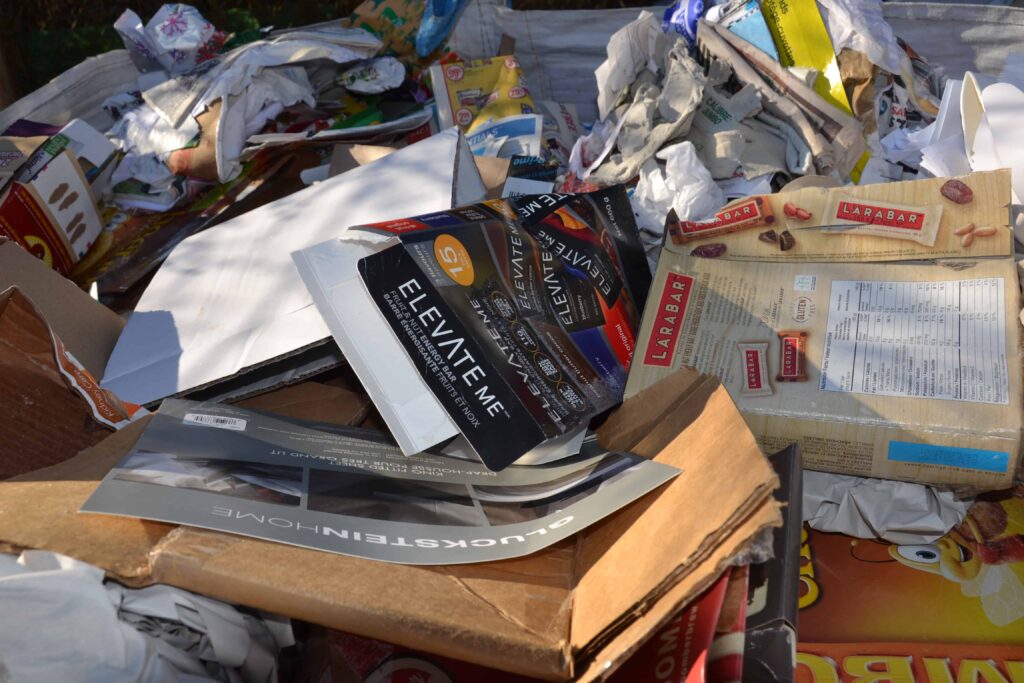The Multi-Material BC (MMBC) recycling program accepts packaging and printed paper from BC residents. But what happens to the material once it is collected?
Packaging and printed paper is collected from residents in three ways: from residents’ curbs, from multi-family buildings, or from depots that accept MMBC materials. Material collected from residents’ curbs and from multi-family buildings is delivered by collection trucks to local receiving facilities operated by MMBC’s contractor, Green by Nature (GBN) EPR. GBN operates, directly or through subcontractors, approximately 45 receiving facilities across BC. Material delivered by residents to MMBC depots is picked up by GBN and delivered to one of GBN’s receiving facilities.
The local receiving facilities are either:
- Transfer facilities, where packaging and printed paper from multiple collectors is consolidated for shipment to a processing facility; or
- Processing facilities, where packaging and printed paper is processed for shipment to re-manufacturers to be used to make new products.
Let’s take a closer look at what happens to different materials.
Containers
Containers are processed to sort the mixture of plastic, steel and aluminum containers and paper packaging that contained liquids to meet the quality specifications set by re-manufacturers, including:
- Various grades of plastic – including polyethylene terephthalate (PET), high density polyethylene (HDPE), polypropylene (PP) and polystyrene (PS) resins – that are each marketed to companies in Canada and the US for the production of new plastic products;
- Steel containers that are marketed to companies in Canada and the US for the production of new steel products;
- Aluminum containers that are marketed to companies in Canada and the US for the production of new aluminum products; and
- Paper packaging that contained liquids is marketed to companies in the US and Korea for the production of new paper products.
Paper
Papers are processed to sort the mixture of printed papers and paper packaging that contained dry product to meet the quality specifications set by re-manufacturers, including
- old newspapers
- old corrugated cardboard
- polycoat containers
- mixed paper
Markets for these commodities are located in Canada, the US, Korea and China. These markets produce various forms of new paper products.
Glass Containers, Plastic Bags and Overwrap, and Plastic Foam Containers
Some packaging, such as plastic bags and overwrap and plastic foam containers and cushion packaging, is only accepted from residents at depots. Glass containers are accepted at depots or may be collected separately from other containers at residents’ curbs or from multi-family buildings, depending on the collector. These materials are segregated from all other packaging and printed paper and kept separate at the transfer and processing facilities during transport and processing. This helps to ensure that these materials meet the quality specifications set by re-manufacturers, including:
- Glass containers are marketed to companies in Canada and the US for manufacture of new glass containers, fibreglass insulation, or aggregate;
- Plastic bags and overwrap are marketed to companies in Canada as polyethylene resin for the production of new polyethylene products; and
- Plastic foam containers and cushion packaging are marketed to companies in Canada, the US and China as polystyrene resin for the production of new polystyrene products.
MMBC will track the amount and type of packaging and printed paper collected and marketed and the final destination of the materials marketed by GBN and report on it annually.


